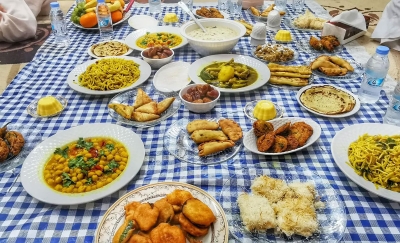

Ramadan Iftar in the Kingdom of Saudi Arabia is the first meal that a fasting person consumes during the holy month of Ramadan in the Kingdom. It commences with the Maghrib call to prayer, with family members gathering around the dining table. Iftar is followed by the Suhoor meal before the Fajr call to prayer. Unlike the conventional three-meal system distributed throughout the day, meals during fasting days begin sequentially in the evening, commencing with Iftar and concluding with Suhoor.
Fasting people in the Kingdom commence their Iftar by consuming dates, water, or milk, along with various juices. This ritual, known in the local dialect as "Fak al-Rik" (breaking the fast), precedes the Maghrib prayer. Subsequently, traditional Ramadan dishes are enjoyed, with the specifics varying depending on the culinary culture of each province within the Kingdom.
Iftar time during the month of Ramadan
Muslims around the world determine the time of Iftar based on the sunset and the Maghrib call to prayer. However, it is common for Muslims living in countries experiencing the midnight sun or polar night phenomenon to follow the timetable of the closest country to them in which night and day can be distinguished.
Foods associated with the Iftar table in the month of Ramadan
Samosa or Sambusa is one of the traditional dishes in the Kingdom, especially in Makkah al-Mukarramahand al-Madinah al-Munawwarah provinces. It is one of the foods associated with the Iftar table in the month of Ramadan. Sambusa has spread in Saudi society and has become a staple of the Ramadan table. The term "Sambusa" derives from its resemblance to the shape of the edge of a Sanbuk, a wooden sailboat.
Drinks also occupy a place on the Ramadan table, including sobia, which is a favorite drink on most Ramadan tables in Jeddah, Makkah al-Mukarramah, and al-Madinah al-Munawwarah. As for hot drinks, the most prominent of them is coffee.
During Ramadan, certain fast foods sold in restaurants and food carts gain popularity, including liver, balila, golden corn kernels, and fresh drinks.
Ramadan Iftar meal in the provinces of Saudi Arabia
Saudi provinces are distinguished by their varied Iftar tables and popular dishes that each province is known for. It is a custom of the people of Riyadh to start their Iftar with Zamzam water, dates, yogurt, and coffee. Popular dishes, such as marqouq, matazeez, and jareesh, are at the top of the Iftar tables. Moreover, well-known traditional foods, such as camel meat (locally called Hashi), as well as Sambusa, Qatayef and Luqaimat, are also served.
Popular dishes are often served during Ramadan in the Eastern Province. Ramadan dishes include Thareed, Saqo, Harees, Jareesh, Luqaimator golden Kadi bites, Marqouq, Marasa’i, Hasawi rice, types of soups, Khabisa, Sambusa, Khanfaroosh, Kibbeh, Mammoush, Mash bread, and Mandi.
In al-Madinah al-Munawwarah, 'al-Habb' soup is one of the main dishes in Iftar of Ramadan, in addition to fried foods such as Sambusa, Furni, Madini puff, Barik, Qadi Qada, Mutabbaq, and Aish Abu al-Laham. Sweets include Kunafa with Ashta, Kunafa with almonds or nuts, Jubniyah, al-Massiyah, Muhalabiyeh, custard, creme, al-Laba, Qatayef, sweet Barik, jelly, vermicelli with cream, Lahouh with sugar, and Luqaimat.
Among the popular foods that the people of Jazan Province make sure to add to their Iftar table are fish, known as "fish Makshan," and Mughash, which consists of meat, potatoes, tomatoes, and zucchini. These ingredients are placed in the Mughash (stone pot), then baked in the Tannur oven before serving it on the Ramadan table. Moreover, Jizan bread, also known as al-Aish or al-Khameer, is made from red or white corn or millet that is crushed, kneaded, and fermented for a day. It is then baked in the Mifa (pottery bowl) before being served with fish Makhshan, Mughash, Sambusa, and different types of soups, in addition to foods such as Zalabiyeh, Halba, and Lahouh, along with various types of juices and dates.
In Jeddah City, fava beans are a main dish in Iftar. As for Dbiyazah, it is a type of sweet popular with the people of Jeddah, Makkah, and al-Madinah. It is prepared at the end of the holy month of Ramadan to be eaten on the days of Eid al-Fitr, especially in the morning of breakfast.
The Iftar table for the people of Makkah al-Mukarramah City consists of the main dish: soup made from crushed beans and meat broth, and all kinds of Sambusa (with meat, cheese, and vegetables), a pasta dish, a fava beans dish, Tamis, and cakes (Sharik), and a hot Daqs salad, in addition to one or more types of pastries. As for desserts, Muhalabieh, jelly, or custard are often served after Iftar with coffee, and Kunafa, Basbousa, or Qatayef are also served. As for drinks, the most popular one is sobia, in addition to tamarind, Qamar al-Din, and other juices, such as raspberry, orange, and lemon with mint.
In al-Bahah Province, Sambusa, soups, Luqaimat, and millet cake dominate the Iftar and Suhoor tables. Some people make sure to enrich their Ramadan table with bread, broth, Qursan, Makhawid, and Machariq, accompanied by yogurt, ghee, and coffee and peel. Moreover, some fruits are also added, such as apricots, peaches, plums, grapes, figs, local bananas, pears, and many other fruits produced by the province's farms. The Bosn (lentil) soup is also popular. It is made from al-Bosn grains, which are widely cultivated in the province.
The Ramadan meal in al-Jawf Province consists of diverse dishes and foods, such as soups, Sambusa, and natural juices, in addition to cold desserts of different shapes and flavors served throughout the month. This dessert is made at home, where women compete in making it. It is an ancient custom and became called “Halla al-Taybeen” (the dessert of good people). Cold desserts in Ramadan were limited to jelly and cream, before more types, shapes, and names appeared.
Ar'ar City in the Northern Borders Province was known for a number of popular customs and traditions that were prevalent during the holy month of Ramadan, including preparing popular dishes for the holy month. These dishes included: al-Malihiyah, al-Khamiaah, al-Fatitah, and al-Mahmousah. People used to eat these meals together, as neighbors and the head of the family would gather at home during Iftar.
The Ramadan meal in Aseer Province consists of Haneeth meat, Sambusa, locally cooked bread, soup, Idamat, and fresh juices.
The Ramadan Iftar table in Hail Province is characterized by Thareed, Maqshush, Aseeda, Jareesh, Harees, and Tamman.
One of the popular dishes on the Ramadan table in Tabuk Province is “al-Mujalala or al-Khami'a” bites. It is a whole wheat dough that is prepared on its own tava. Likewise, the Mansaf dish consists of meat, rice, and Shrak bread, in addition to Saj bread made from black wheat flour. Ramadan tables in Tabuk Province include a dish of Yakhni or Maqtouta, which is prepared from lamb. Its name varies depending on the governorates of the province.
Dishes on the Ramadan table in Qassim Province vary. They include Luqaimat, Marasei, Sambusa, Tawa, all kinds of soups, Matazeez, and Qursan.
The Ramadan meal in Najran Province is characterized by a variety of foods, including some foods that people are familiar with in the provinces of the Kingdom, such as soup, Sambusa, pasta, fruits, and vegetables. Some well-known dishes in the province include "Raqsh," which consists of whole wheat flakes baked on a tava called "Salat." Houses in Najran make sure to include Najran Khalas dates, Ratib Najran, or Nabut Najran dates in Ramadan meals.
Iftar as part of the social culture in Saudi Arabia
Iftar in Ramadan is a valuable opportunity seized by community initiatives in the Kingdom, based on the principle of human participation. Collective iftars are organized in the outdoor courtyards of mosques. Volunteers of all ages also stand around traffic lights to distribute iftar meals to fasting people. Moreover, neighborhood residents organize daily iftar initiatives to volunteer food to guests, workers in public parks, and rehabilitation centers.
Such initiatives undertaken by charities are known as “Iftar Sa’im" (breakfast for a fasting person), predominantly consisting of Saudi dates, as it is the first food that Muslims usually eat during Iftar.
It is also common for neighbors in the Kingdom to exchange food dishes ahead of iftar, and families gather around tables serving various types of food, depending on the province's specific culture.
Health guidelines for Ramadan
The Public Health Authority, through the Health Promotion and Improvement Affairs Initiative, publishes a health guide every year to raise social awareness in terms of food culture and behavior for diabetics, and pregnant and lactating women, in addition to promoting mental, social, and nutritional health during Ramadan.
Related quizzes
Related articles

